
° Semiconductor
MSM548263
1/40
° Semiconductor
MSM548263
262,144-Word
• 8-Bit Multiport DRAM
DESCRIPTION
The MSM548263 is a 2-Mbit CMOS multiport DRAM composed of a 262,144-word by 8-bit
dynamic RAM, and a 512-word by 8-bit SAM. Its RAM and SAM operate independently and
asynchronously.
It supports three types of operations: random access to RAM port, high speed serial access to
SAM port, and bidirectional transfer of data between any selected row in the RAM port and the
SAM port. In addition to the conventional multiport DRAM operating modes, the MSM548263
features block write, flash write functions and extended page mode on the RAM port and a split
data transfer capability, programmable stops on the SAM port. The SAM port requires no refresh
operation because it uses static CMOS flip-flops.
FEATURES
∑ Single power supply: 5 V
±
10%
∑ Full TTL compatibility
∑ Multiport organization
RAM : 256K word • 8 bits
SAM : 512 word • 8 bits
∑ Extended page mode
∑ Write per bit
∑ Persistent write per bit
∑ Masked flash write
∑ Masked block write
∑ Package options:
40-pin 400 mil plastic SOJ
(SOJ40-P-400-1.27)
(Product : MSM548263-xxJS)
44/40-pin 400 mil plastic TSOP (Type II)(TSOPII44/40-P-400-0.80-K)(Product : MSM548263-xxTS-K)
xx indicates speed rank.
PRODUCT FAMILY
∑ RAS only refresh
∑ CAS before RAS refresh
∑ Hidden refresh
∑ Serial read/write
∑ 512 tap location
∑ Programmable stops
∑ Bidirectional data transfer
∑ Split transfer
∑ Masked write transfer
∑ Refresh: 512 cycles/8 ms
Access Time
Cycle Time
Power Dissipation
RAM
RAM
Operating
Standby
SAM
SAM
60 ns
120 ns
140 mA
8 mA
17 ns
22 ns
70 ns
140 ns
130 mA
8 mA
17 ns
22 ns
80 ns
150 ns
120 mA
8 mA
20 ns
25 ns
Family
MSM548263-60
MSM548263-70
MSM548263-80
E2L0017-17-Y1
This version: Jan. 1998
Previous version: Dec. 1996

° Semiconductor
MSM548263
2/40
PIN CONFIGURATION (TOP VIEW)
Pin Name
Function
A0 - A8
Address Input
RAS
Row Address Strobe
CAS
Column Address Strobe
TRG
Transfer/Output Enable
WE
Write Enable
Pin Name
Function
SC
Serial Clock
SE
SAM Port Enable
DSF
Special Function Input
V
CC
Power Supply (5 V)
NC
No Connection
DQ1 - DQ8
RAM Inputs/Outputs
SDQ1 - SDQ8
SAM Inputs/Outputs
QSF
Special Function Output
V
SS
Ground (0 V)
40-Pin Plastic SOJ
44/40-Pin Plastic TSOP (
II)
(K Type)
SDQ1
SDQ2
SDQ3
SDQ4
TRG
DQ1
DQ2
DQ3
A5
A4
V
CC
V
SS
SDQ7
SDQ6
SDQ5
DQ5
V
SS
DSF
NC
CAS
QSF
A0
A1
A2
A3
V
SS
30
29
28
27
26
25
23
22
21
24
SE
DQ8
DQ7
DQ6
1
2
3
4
5
6
7
8
9
10
11
12
13
14
15
16
17
18
19
20
34
33
32
31
38
37
36
35
V
CC
DQ4
V
SS
WE
A6
A7
A8
RAS
SDQ8
SC
39
40
1
V
CC
22
V
CC
2
SC
3
SDQ1
4
SDQ2
5
SDQ3
6
SDQ4
7
TRG
8
DQ1
9
DQ2
10
DQ3
13
DQ4
14
V
SS
15
WE
16
RAS
17
A8
18
A7
19
A6
20
A5
21
A4
44 V
SS
23 V
SS
43 SDQ8
42 SDQ7
41 SDQ6
40 SDQ5
39 SE
38 DQ8
37 DQ7
36 DQ6
35 DQ5
32 V
SS
31 DSF
30 NC
29 CAS
28 QSF
27 A0
26 A1
25 A2
24 A3
Note:
The same power supply voltage must be provided to every V
CC
pin, and the same GND
voltage level must be provided to every V
SS
pin.
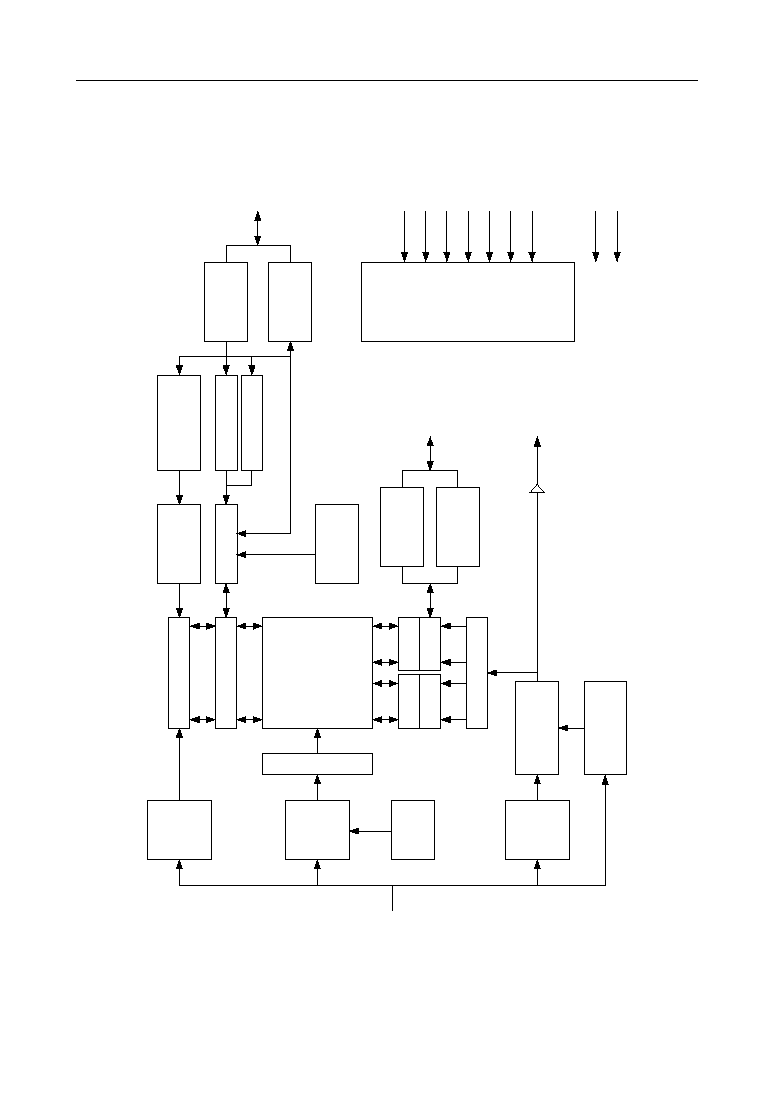
° Semiconductor
MSM548263
3/40
BLOCK DIAGRAM
Column
Address
Buffer
Row
Address
Buffer
Refresh
Counter
A0 - A8
SAM
Address
Buffer
SAM Address
Counter
SAM Stop
Control
Row Decoder
Column Decoder
Sense Amp.
512 • 512 • 8
RAM ARRAY
Gate
SAM
Gate
SAM
SDQ 1 - 8
QSF
Serial Decoder
Block Write
Control
I/O Control
Flash Write
Control
SAM Input
Buffer
SAM Output
Buffer
Column Mask
Register
Color Register
Mask Register
RAM Input
Buffer
RAM Output
Buffer
Timing
Generator
RAS
CAS
TRG
WE
DSF
SC
SE
V
CC
V
SS
DQ 1 - 8
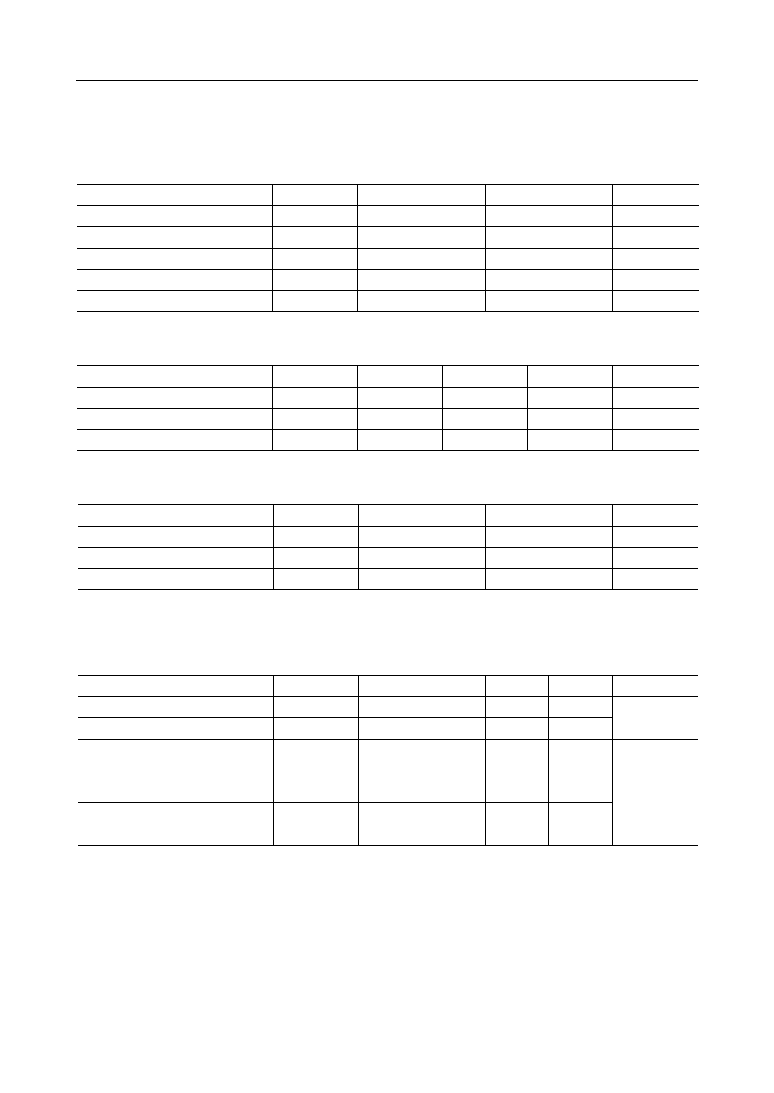
° Semiconductor
MSM548263
4/40
ELECTRICAL CHARACTERISTICS
Absolute Maximum Ratings
Parameter
Symbol
Rating
Unit
Input Output Voltage
V
T
≠1.0 to 7.0
V
Output Current
I
OS
50
mA
Power Dissipation
P
D
1
W
Operating Temperature
T
opr
0 to 70
∞C
Storage Temperature
T
stg
≠55 to 150
∞C
Condition
Ta = 25∞C
Ta = 25∞C
Ta = 25∞C
--
--
(Note: 1)
Recommended Operating Conditions
Parameter
Symbol
Unit
Power Supply Voltage
V
CC
V
Input High Voltage
V
IH
V
Input Low Voltage
V
IL
V
Min.
4.5
2.4
≠1.0
Typ.
5.0
--
--
Max.
5.5
6.5
0.8
(Ta = 0∞C to 70∞C) (Note: 2)
Capacitance
Parameter
Symbol
Min.
Unit
Input Capacitance
C
i
--
pF
Input/Output Capacitance
C
io
--
pF
Max.
8
9
Output Capacitance
C
o
(QSF)
--
pF
9
(V
CC
= 5 V ±10%, f = 1 MHz, Ta = 25∞C)
Note:
This parameter is periodically sampled and is not 100% tested.
DC Characteristics 1
Parameter
Symbol
Condition
Output "H" Level Voltage
V
OH
I
OH
= ≠1 mA
Output "L" Level Voltage
V
OL
I
OL
= 2.1 mA
Input Leakage Current
I
LI
0 £ V
IN
£ V
CC
All other pins not
under test = 0 V
Min.
2.4
--
≠10
Max.
--
0.4
10
Unit
V
mA
Output Leakage Current
I
LO
0 £ V
OUT
£ 5.5 V
Output Disable
≠10
10

° Semiconductor
MSM548263
5/40
DC Characteristics 2
-60
-70
-80
Unit Note
Symbol
Item (RAM)
SAM
Max. Max. Max.
95
85
75
mA
3, 4
I
CC1
Operating Current
Standby
140
130
120
17
(RAS, CAS Cycling, t
RC
= t
RC
min.)
Active
8
8
8
Standby Current
60
55
50
3, 4
(RAS, CAS = V
IH
)
95
85
75
3, 4
RAS Only Refresh Current
140
130
120
17
(RAS Cycling, CAS = V
IH
, t
RC
= t
RC
min.)
75
70
65
3, 4
Page Mode Current
140
130
120
18
(RAS = V
IL
, CAS Cycling, t
PC
= t
PC
min.)
95
85
75
3, 4
CAS before RAS Refresh Current
140
130
120
3, 4
(RAS Cycling, CAS before RAS, t
RC
= t
RC
min.)
95
85
75
3, 4
Data Transfer Current
140
130
120
17
(RAS, CAS Cycling, t
RC
= t
RC
min.)
95
85
75
3, 4
Flash Write Current
140
130
120
3, 4
(RAS, CAS Cycling, t
RC
= t
RC
min.)
95
85
75
3, 4
Block Write Current
140
130
120
3, 4
(RAS, CAS Cycling, t
RC
= t
RC
min.)
I
CC1
A
I
CC2
I
CC2
A
I
CC3
I
CC3
A
I
CC4
I
CC4
A
I
CC5
I
CC5
A
I
CC6
I
CC6
A
I
CC7
I
CC7
A
I
CC8
I
CC8
A
Standby
Active
Standby
Active
Standby
Active
Standby
Active
Standby
Active
Standby
Active
Standby
Active
(V
CC
= 5 V ±10%, Ta = 0∞C to 70∞C)

° Semiconductor
MSM548263
6/40
AC Characteristics (1/3)
Parameter
Symbol
Note
Unit
ns
150
140
--
120
ns
40
35
30
--
ns
25
20
15
--
ns
45
40
35
--
ns
35
3
35
3
35
3
ns
100k
80
100k
70
100k
60
t
RC
t
PRWC
t
AA
t
CAC
t
CPA
t
RASP
t
CAS
t
RCD
Max.
Min.
Max.
Min.
Max.
Min.
-80
-70
-60
ns
90
90
--
85
ns
10k
25
10k
20
10k
15
14
20
20
20
ns
50
45
--
40
t
PC
t
RAC
ns
80
70
60
--
10
ns
20
0
20
0
15
0
t
OFF
ns
--
60
--
60
--
50
ns
--
25
--
20
--
15
t
RSH
ns
--
80
--
70
--
60
t
CSH
t
T
t
RP
ns
10k
80
10k
70
10k
60
t
RAS
t
RAD
14
15
15
15
t
ASR
0
0
0
t
RAH
10
10
10
t
ASC
0
0
0
t
CAH
12
10
10
t
AR
55
55
50
t
RCS
0
0
0
t
RCH
11
0
0
0
t
RRH
11
0
0
0
t
WCS
0
0
0
t
WCH
15
12
10
t
WCR
55
55
50
t
WP
15
12
10
t
RWL
20
20
15
t
CWL
20
20
15
8, 14
8, 15
8, 15
8, 14
7
ns
55
50
45
ns
40
35
30
ns
ns
ns
ns
ns
ns
ns
ns
ns
ns
ns
ns
ns
ns
ns
195
185
--
170
t
RWC
t
CRL
0
0
0
ns
t
RCL
0
0
0
ns
t
COH
5
5
5
ns
t
RAL
t
CRP
ns
--
40
--
35
--
30
10
10
10
t
CP
10
10
10
ns
ns
19
13
--
--
--
--
--
--
--
--
--
--
--
--
--
--
--
--
--
--
--
--
--
--
--
--
--
--
--
--
--
--
--
--
--
--
--
--
--
--
--
--
--
--
--
--
--
--
--
--
--
--
--
--
--
--
--
--
--
--
--
--
--
--
--
--
--
--
--
--
--
--
--
--
--
Access Time from Column Address
Column Address Hold Time referenced to RAS
Column Address Set-up Time
Row Address Set-up Time
Access Time from CAS
Column Address Hold Time
CAS Pulse Width
CAS Precharge Time (Fast Page Mode)
Access Time from CAS Precharge
CAS to RAS Precharge Time
CAS Hold Time
Write Command to CAS Lead Time
Output Buffer Turn-off Delay
CAS "H" to RAS "H" Lead Time
RAS "H" to CAS "H" Lead Time
Fast Page Mode Cycle Time
Fast Page Mode Read Modify Write Cycle Time
Row Address Hold Time
RAS Pulse Width (Fast Page Mode Only)
Random Read or Write Cycle Time
RAS to CAS Delay Time
Read Command Hold Time
Read Command Set-up Time
Read Modify Write Cycle
RAS Precharge Time
Read Command Hold Time referenced to RAS
Write Command to RAS Lead Time
Access Time from RAS
RAS to Column Address Delay Time
Column Address to RAS Lead Time
RAS Pulse Width
RAS Hold Time
Transition Time (Rise and Fall)
Write Command Hold Time referenced to RAS
Write Command Set-up Time
Write Command Pulse Width
Write Command Hold Time
Data Output Hold after CAS Low
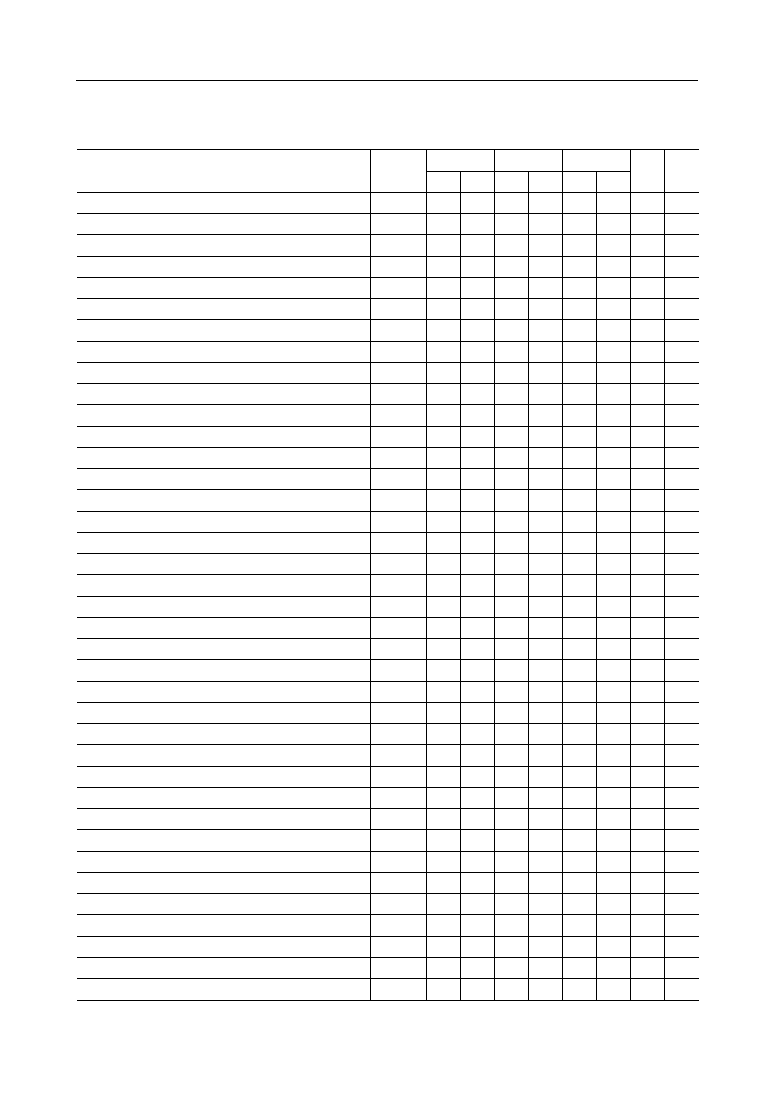
° Semiconductor
MSM548263
7/40
AC Characteristics (2/3)
Parameter
Symbol
Note
Unit
ns
45
40
35
ns
0
0
0
ns
0
0
0
ns
10
0
10
0
10
0
ns
10
10
10
t
RWD
t
CWD
t
DZC
t
DZO
t
CSR
t
REF
t
WSR
Max.
Min.
Max.
Min.
Max.
Min.
-80
-70
-60
ns
100
90
80
ms
8
8
8
0
0
0
t
AWD
ns
65
55
50
ns
20
--
20
--
15
--
t
OEA
ns
10
10
10
ns
10
10
10
t
CHR
ns
0
0
0
t
RPC
t
OEZ
t
OEH
ns
15
15
10
t
ROH
t
RWH
12
10
10
t
FSC
0
0
0
t
CFH
12
10
10
t
MS
0
0
0
t
MH
12
10
10
t
THS
0
0
0
t
THH
12
10
10
t
TLS
0
0
0
t
TLH
12
10
10
t
TRP
60
60
50
t
TP
20
20
20
t
RSD
80
70
60
t
ASD
45
45
40
t
CSD
25
20
20
t
TSL
5
5
5
13
13
ns
ns
ns
ns
ns
ns
ns
ns
ns
ns
10k
10k
10k
ns
ns
ns
ns
ns
ns
t
RTH
65
60
50
ns
10k
10k
10k
t
ATH
30
25
20
ns
t
CTH
25
20
15
ns
t
FSR
t
RFH
ns
0
0
0
12
10
10
t
FHR
55
55
50
ns
ns
13
Column Address to First SC Delay Time
Column Address to WE Delay Time
CAS Hold Time for CAS before RAS Cycle
CAS Set-up Time for CAS before RAS Cycle
CAS to WE Delay Time
Data to CAS Delay Time
Data to TRG Delay Time
DSF Set-up Time referenced to RAS
Write Per Bit Mask Data Hold Time
Write Per Bit Mask Data Set-up Time
TRG Command Hold Time
Refresh Period
DSF Hold Time referenced to RAS (1)
RAS Hold Time referenced to TRG
RAS Precharge to CAS Active Time
RAS to WE Delay Time
WE Hold Time
Access Time from TRG
RAS to First SC Delay Time (Read Transfer)
TRG to RAS Precharge Time
WE Set-up Time
Last SC to TRG Lead Time
Output Buffer Turn-off Delay from TRG
DSF Hold Time referenced to RAS (2)
DSF Hold Time referenced to CAS
TRG Low Hold Time referenced to Column Address
TRG Low Hold Time referenced to CAS
TRG
Precharge Time
--
--
--
--
--
--
--
--
--
--
--
--
--
--
--
--
--
--
--
--
--
--
--
--
--
--
--
--
--
--
--
--
--
--
--
--
--
--
--
--
--
--
--
--
--
--
--
--
--
--
--
--
--
--
--
--
--
--
--
--
--
--
--
--
--
--
--
--
--
--
--
--
--
--
--
--
--
--
--
--
--
--
--
--
--
--
--
--
--
--
--
--
--
DSF Set-up Time referenced to CAS
TRG High Hold Time
TRG High Set-up Time
TRG Low Hold Time
TRG Low Set-up Time
TRG Low Hold Time referenced to RAS
CAS to First SC Delay Time (Read Transfer)
ns
--
0
--
0
--
0
t
DS
ns
55
55
50
t
DHR
ns
15
12
10
t
DH
12
12
Data Hold Time
Data Hold Time referenced to RAS
Data Set-up Time
--
--
--
--
--
--
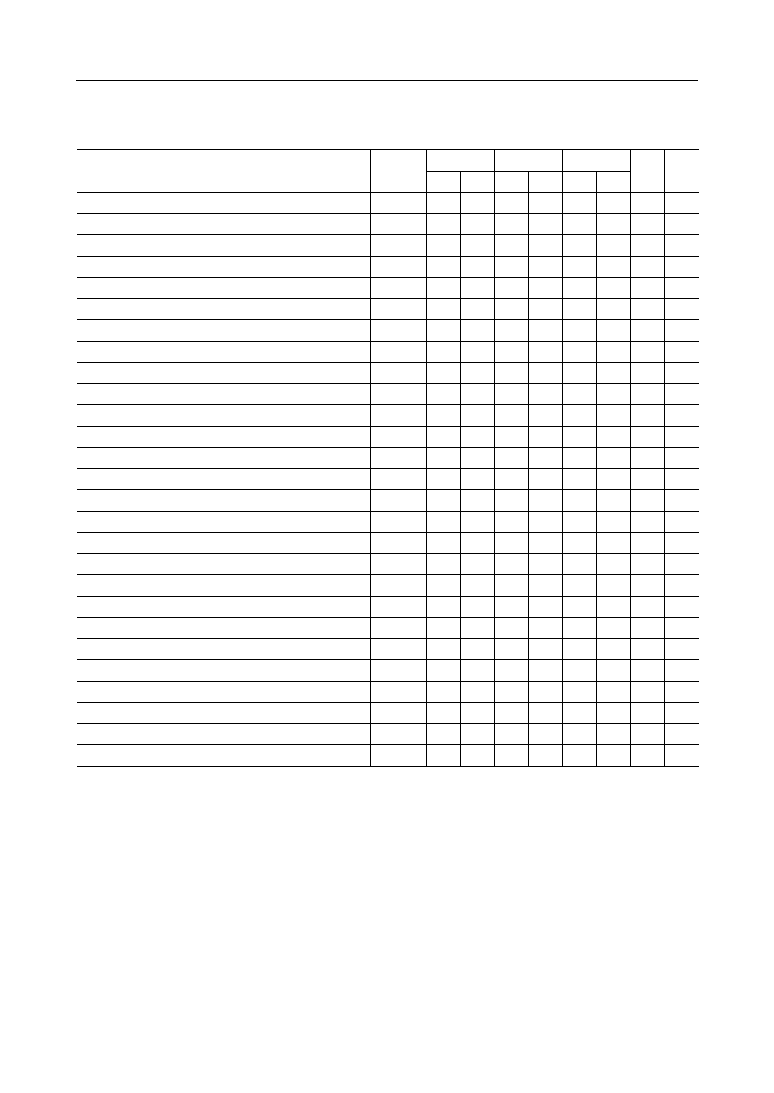
° Semiconductor
MSM548263
8/40
AC Characteristics (3/3)
Parameter
Symbol
Note
Unit
ns
7
5
5
ns
20
17
17
ns
5
5
5
ns
10
10
10
ns
30
25
25
t
SCC
t
SCP
t
SCA
t
SOH
t
STS
t
TQD
t
CQD
Max.
Min.
Max.
Min.
Max.
Min.
-80
-70
-60
ns
25
22
22
ns
25
25
25
t
SC
ns
7
5
5
9
ns
20
--
17
17
t
SEA
ns
10
10
10
ns
30
25
25
t
STH
ns
25
25
25
t
SQD
t
SE
t
SEP
ns
20
0
20
0
20
0
t
SEZ
t
RQD
t
SZE
0
0
0
t
SZS
0
0
0
t
SWS
0
0
0
t
SWH
12
10
10
t
SWIS
0
0
0
t
SWIH
12
10
10
9
19
10
ns
35
35
30
ns
75
75
70
ns
ns
ns
ns
ns
ns
t
SDD
t
SDS
ns
40
40
30
0
0
0
t
SDH
12
10
10
ns
ns
Access Time from SC
SC-QSF Delay Time
SC Pulse Width (SC High Time)
SC Cycle Time
SC Precharge Time (SC Low Time)
RAS to Serial Input Delay Time
Split Transfer Hold Time
Split Transfer Set-up Time
SE Pulse Width
Access Time from SE
SE Precharge Time
Serial Write Disable Hold Time
Serial Write Disable Set-up Time
Serial Write Enable Set-up Time
Serial Input to SE Delay Time
Serial Input to First SC Delay Time
Serial Output Buffer Turn-off Delay from SE
Serial Output Hold Time from SC
Serial Write Enable Hold Time
--
--
--
--
--
--
--
--
--
--
--
--
--
--
--
--
--
--
--
--
--
--
--
--
--
--
--
--
--
--
--
--
--
--
--
--
--
--
--
--
--
--
--
--
--
--
--
--
--
--
--
--
--
--
--
--
--
--
--
--
--
--
--
--
--
--
--
--
TRG-QSF Delay Time
CAS-QSF Delay Time
RAS-QSF Delay Time
Serial Input Hold Time
Serial Input Set-up Time
ns
--
15
--
15
--
15
t
TSD
ns
40
10
40
10
30
10
t
SDZ
ns
25
25
20
t
SRS
10
Serial Output Buffer Turn-off Delay from RAS
TRG to First SC Delay Time (Read Transfer)
Last SC to RAS Set-up Time (Serial Input)
--
--
--

° Semiconductor
MSM548263
9/40
Notes:
1. Exposure beyond the "Absolute Maximum Ratings" may cause permanent damage
to the device.
2. All voltages are referenced to V
SS
.
3. These parameters depend on the cycle rate.
4. These parameters depend on output loading. Specified values are obtained with the
output open.
5. An initial pause of 200 ms is required after power up followed by any 8 RAS cycles
(TRG = "high") and any 8 SC cycles before proper device operation is achieved.
In the case of using an internal refresh counter, a minimum of 8 CAS before RAS
cycles instead of 8 RAS cycles are required.
6. AC measurements assume t
T
= 5 ns.
7. V
IH
(Min.) and V
IL
(Max.) are reference levels for measuring timing of input signals.
Also, transition times are measured between V
IH
and V
IL
.
8. RAM port outputs are measured with a load equivalent to 1 TTL load and 50 pF.
DOUT reference levels : V
OH
/V
OL
= 2.0 V/0.8 V.
9. SAM port outputs are measured with a load equivalent to 1 TTL load and 30 pF.
DOUT
reference levels : V
OH
/V
OL
= 2.0 V/0.8 V.
10. t
OFF
(Max.), t
OEZ
(Max.), t
SDZ
(Max.) and t
SEZ
(Max.) define the time at which the
outputs achieve the open circuit condition, and are not referenced to output voltage
levels. This parameter is sampled and not 100% tested.
11. Either t
RCH
or t
RRH
must be satisfied for a read cycle.
12. These parameters are referenced to CAS leading edge of early write cycles, and to
WE leading edge in TRG controlled write cycles and read modify write cycles.
13. t
WCS
, t
RWD
, t
CWD
and t
AWD
are not restrictive operating parameters.
They are included in the data sheet as electrical characteristics only.
If t
WCS
t
WCS
(Min.), the cycle is an early write cycle, and the data out pin will
remain open circuit throughout the entire cycle; If t
RWD
t
RWD
(Min.), t
CWD
t
CWD
(Min.) and t
AWD
t
AWD
(Min.), the cycle is a read modify write cycle, and the data
out will contain data read from the selected cell; If neither of the above sets of
conditions are satisfied, the condition of the data out is indeterminate.
14. Operation within the t
RCD
(Max.) limit ensures that t
RAC
(Max.) can be met.
t
RCD
(Max.) is specified as a reference point only: If t
RCD
is greater than the specified
t
RCD
(Max.) limit, then access time is controlled by t
CAC
.
15. Operation within the t
RAD
(Max.) limit ensures that t
RAC
(Max.) can be met. t
RAD
(Max.) is specified as a reference point only: If t
RAD
is greater than the specified t
RAD
(Max.) limit, then access time is controlled by t
AA
.
16. Input levels at the AC testing are 3.0 V/0 V.
17. Address (A0 - A8) may be changed two times or less while RAS = V
IL
.
18. Address (A0 - A8) may be changed once or less while CAS = V
IH
and RAS = V
IL
.
19. This is guaranteed by design. (t
SOH
/t
COH
= t
SCA
/t
CAC
- output transition time)
This parameter is not 100% tested.

° Semiconductor
MSM548263
10/40
TIMING WAVEFORM
Read Cycle (Outputs Controlled by RAS)
RAS
CAS
Address
DSF
WE
DQ1 - 8
TRG
,
,,
,,
t
RC
t
RAS
t
RP
t
RCD
t
CAS
t
RSH
t
CSH
t
CRL
t
CRP
t
AR
t
RAD
t
RAL
t
FSR
Row
Column
t
RAH
t
ASC
t
CAH
t
RFH
t
CFH
t
FSC
t
FHR
t
RCS
t
RCH
t
CAC
t
RAC
t
AA
t
RRH
t
OFF
Valid Data
t
OEA
t
ROH
t
OEZ
t
THH
t
THS
t
ASR
"H" or "L"
Open
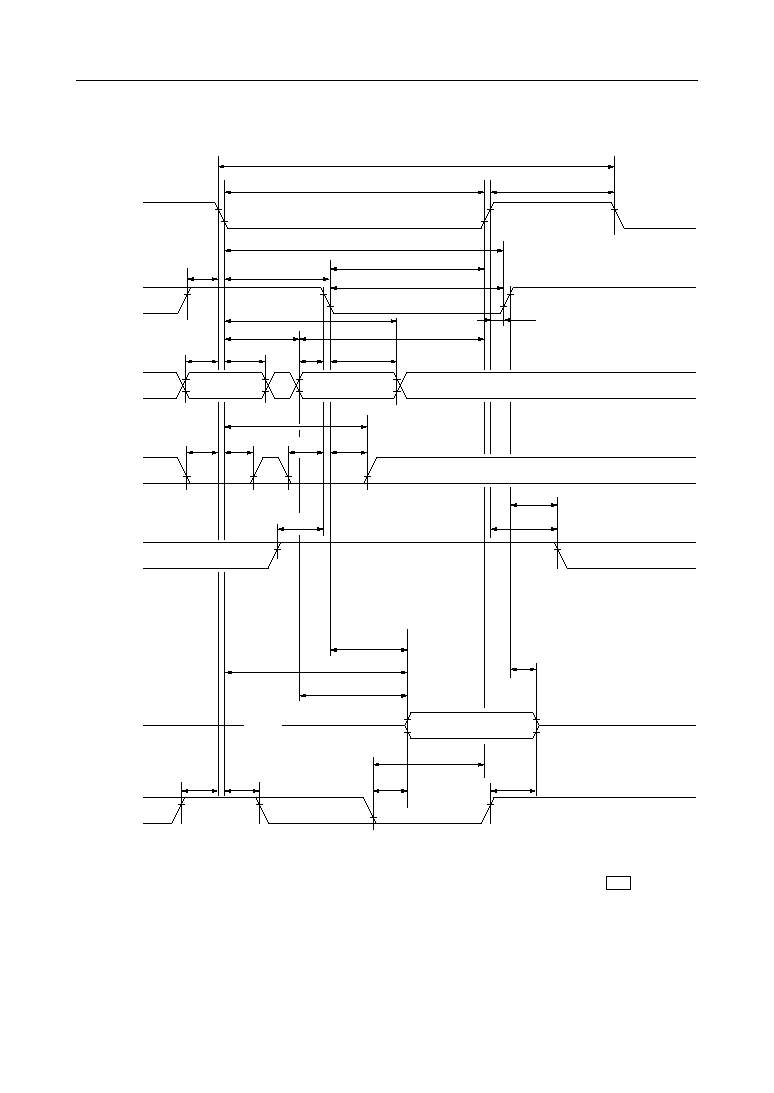
° Semiconductor
MSM548263
11/40
Read Cycle (Outputs Controlled by CAS)
RAS
CAS
Address
DSF
WE
DQ1 - 8
TRG
,
,,
,,
t
RC
t
RAS
t
RP
t
RCD
t
CAS
t
RSH
t
CSH
t
RCL
t
CRP
t
AR
t
RAD
t
RAL
t
FSR
Row
Column
t
RAH
t
ASC
t
CAH
t
RFH
t
CFH
t
FSC
t
FHR
t
RCS
t
RCH
t
CAC
t
RAC
t
AA
t
RRH
t
OFF
Valid Data
t
OEA
t
ROH
t
OEZ
t
THH
t
THS
t
ASR
"H" or "L"
Open

° Semiconductor
MSM548263
12/40
Extended Page Mode Read Cycle
RAS
CAS
Address
DSF
WE
DQ1 - 8
TRG
,
,
,
"H" or "L"
t
RASP
t
RP
t
RCD
t
CAS
t
CSH
t
CRP
t
AR
t
RAD
t
FSR
Row
Column
t
RAH
t
ASC
t
CAH
t
RFH
t
CFH
t
FSC
t
FHR
t
RCS
t
RCH
t
CAC
t
RAC
t
AA
t
RRH
Valid Data
t
OEA
t
OEZ
t
OEA
t
THH
t
THS
t
ASR
,
Column
Column
t
OFF
Valid Data
t
CP
t
PC
t
CAS
t
CP
t
CAS
t
RSH
t
ASC
t
CAH
t
ASC
t
CAH
t
RAL
t
CFH
t
FSC
t
CFH
t
FSC
t
RCH
t
RCS
t
RCH
t
RCS
t
CAC
t
COH
t
CAC
t
COH
Valid
Data
Valid
Data
t
AA
t
CPA
t
AA
t
CPA
Open

° Semiconductor
MSM548263
13/40
Write Cycle Function Table
Code
RWM
BWM
FWM
RW
BW
LMR
LCR
A
DSF
0
0
1
0
0
1
1
RAS Falling Edge
C
WE
0
0
0
1
1
1
1
D
DQ
Write Mask
Write Mask
Write Mask
X
X
X
X
B
DSF
0
1
X
0
1
0
1
CAS Falling Edge
E
DQ
Valid Data
Column Mask
X
Valid Data
Column Mask
Write Mask Data
Color Data
Function
Masked Write (New/Old)
Masked Block Write (New/Old)
Masked Flash Write (New/Old)
Normal Write
Block Write
Load Mask Register
Load Color Register
WRITE MASK DATA: "Low" = Mask, "High" = No Mask
Column Mask Data
DQ1 - 4
DQ1
DQ2
DQ3
DQ4
Column Mask Data
Column 0 (A0 = 0, A1 = 0)
Column 1 (A0 = 1, A1 = 0)
Column 2 (A0 = 0, A1 = 1)
Column 3 (A0 = 1, A1 = 1)
Low: Mask
High: No Mask
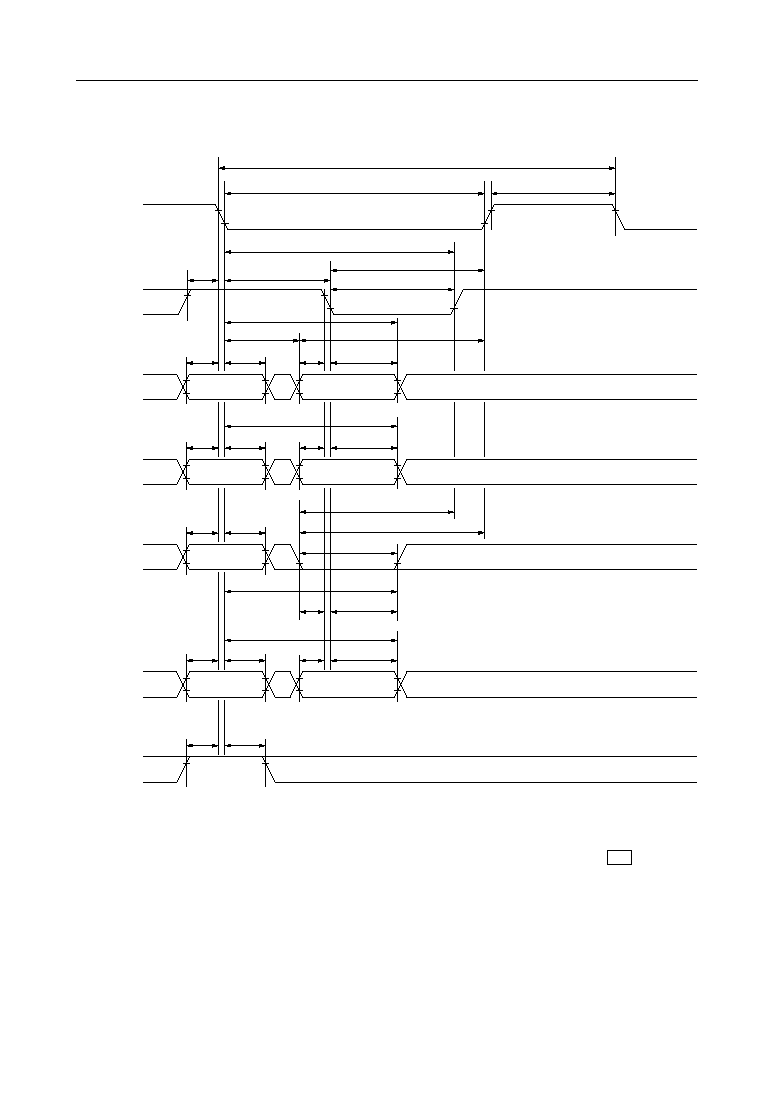
° Semiconductor
MSM548263
14/40
Early Write Cycle
RAS
CAS
Address
t
RC
t
RAS
t
RP
t
RCD
t
CAS
t
RSH
t
CSH
t
CRP
t
AR
t
RAD
t
RAL
Row
Column
t
RAH
t
ASC
t
CAH
t
ASR
"H" or "L"
DSF
,
,,
A
B
t
RFH
t
FSC
t
CFH
t
FSR
WE
C
t
RWH
t
WP
t
WSR
DQ1 - 8
D
E
t
MH
t
DS
t
DH
t
MS
TRG
t
THH
t
THS
,
,,,
t
RWL
t
CWL
t
FHR
t
WCR
t
DHR
t
WCS
t
WCH

° Semiconductor
MSM548263
15/40
Late Write Cycle
RAS
CAS
Address
t
RC
t
RAS
t
RP
t
RCD
t
CAS
t
RSH
t
CSH
t
CRP
t
AR
t
RAD
t
RAL
Row
Column
t
RAH
t
ASC
t
CAH
t
ASR
"H" or "L"
DSF
,
,,
A
B
t
RFH
t
FSC
t
CFH
t
FSR
WE
C
t
RWH
t
WP
t
WSR
DQ1 - 8
D
E
t
MH
t
DS
t
DH
t
MS
TRG
t
OEH
t
THS
,
,,
t
RWL
t
CWL
t
FHR
t
WCR
t
DHR
t
RCS

° Semiconductor
MSM548263
16/40
Read Modify Write Cycle
RAS
CAS
Address
t
RWC
t
RAS
t
RP
t
RCD
t
CAS
t
RSH
t
CSH
t
CRP
t
AR
t
RAD
t
RAL
Row
Column
t
RAH
t
ASC
t
CAH
t
ASR
"H" or "L"
DSF
,
,,
A
B
t
RFH
t
FSC
t
CFH
t
FSR
WE
C
t
RWH
t
WP
t
WSR
DQ1 - 8
D
E
t
MH
t
DS
t
DH
t
MS
TRG
t
OEH
t
THS
,
,,
t
RWL
t
CWL
t
FHR
t
RWD
t
RAC
t
RCS
t
AWD
t
DZC
t
OEA
t
OEZ
Valid
Data
t
CAC
t
THH
t
DZO
t
CWD

° Semiconductor
MSM548263
17/40
Fast Page Mode Early Write Cycle
t
DH
t
DS
t
DS
t
DH
t
DH
t
DS
t
MH
t
MS
RAS
CAS
Address
t
RASP
t
RP
t
RCD
t
CAS
t
RSH
t
CSH
t
CRP
t
AR
t
RAD
t
RAL
Row
Column
t
RAH
t
ASC
t
CAH
t
ASR
"H" or "L"
DSF
A
B
t
RFH
t
FSC
t
CFH
t
FSR
WE
,
C
t
RWH
t
WP
t
WSR
DQ1 - 8
TRG
t
THH
t
THS
,
t
CWL
t
FHR
Column
t
ASC
t
CAH
B
t
FSC
t
CFH
Column
t
ASC
t
CAH
B
t
FSC
t
CFH
,
,
D
E
,
E
E
,
t
WCH
t
WCS
t
WP
t
WCH
t
WCS
t
WP
t
WCH
t
WCS
t
CWL
t
CWL
t
CAS
t
CAS
t
CP
t
CP
t
PC

° Semiconductor
MSM548263
18/40
Fast Page Mode Read Modify Write Cycle
t
MH
t
MS
RAS
CAS
Address
t
RASP
t
RP
t
RCD
t
CAS
t
RSH
t
CSH
t
CRP
t
AR
t
RAD
t
RAL
Row
Column
t
RAH
t
ASC
t
CAH
t
ASR
,
"H" or "L"
DSF
A
B
t
RFH
t
FSC
t
CFH
t
FSR
WE
,
C
t
RWH
t
WP
t
WSR
DQ1 - 8
TRG
t
THH
t
THS
,
t
CWL
t
FHR
Column
t
ASC
t
CAH
B
t
FSC
t
CFH
Column
t
ASC
t
CAH
B
t
FSC
t
CFH
D
In
t
DS
t
DH
t
AWD
t
CAS
t
CAS
t
CP
t
CP
t
PRWC
t
WP
t
WP
t
CWD
t
CWD
t
CWD
t
RCS
t
AWD
t
CWL
t
CWL
t
AWD
Out
t
CAC
t
AA
In
t
DS
t
DH
Out
t
CAC
t
AA
In
t
DS
t
DH
Out
t
CAC
t
AA
t
OEZ
t
OEA
t
OEZ
t
OEA
t
OEZ
t
OEA

° Semiconductor
MSM548263
19/40
RAS Only Refresh Cycle
RAS
CAS
Address
t
RC
t
RAS
t
RP
t
CRP
Row
t
RAH
t
ASR
"H" or "L"
DSF
WE
DQ1 - 8
TRG
t
THH
t
THS
,
,,,
t
RFH
t
FSR
,
,,,
t
RPC
Open

° Semiconductor
MSM548263
20/40
CAS before RAS Refresh Cycle
RAS
CAS
Address
t
RC
t
RAS
t
RP
t
CSR
A
t
RAH
t
ASR
"H" or "L"
DSF
WE
DQ1 - 8
TRG
,,,,
t
RPC
t
RP
t
RPC
t
CHR
Inhibit Falling Transition
,
,,,
B
t
RFH
t
FSR
C
t
RWH
t
WSR
t
OFF
Open
Note:
The type of CBR operations are determined by the logic states of "A", "B" and "C".
CBR Cycle Function Table
Code
CBRR
CBRS
CBRN
RAS Falling Edge
A
X
STOP Address
X
B
0
1
1
C
1
0
1
Function
CBR Refresh (Reset All Options)
CBR Refresh (Set STOP Address)
CBR Refresh (No Reset Options)

° Semiconductor
MSM548263
21/40
Hidden Refresh Cycle
Note:
The type of CBR operations are determined by the logic states of "A", "B" and "C".
RAS
CAS
Address
t
RC
t
RAS
t
RP
t
RCD
t
CHR
t
RSH
t
CRP
t
AR
t
RAD
t
RAL
Row
Column
t
RAH
t
ASC
t
CAH
t
ASR
"H" or "L"
DSF
,
t
RFH
t
FSC
t
CFH
t
FSR
WE
C
t
WSR
t
RWH
DQ1 - 8
Valid Data
TRG
t
THH
t
THS
,
,
t
FHR
t
RRH
t
RAS
,
,
B
t
FSR
t
RFH
A
t
ASR
t
RAH
t
RCS
t
OFF
t
AA
t
RAC
t
CAC
t
OEZ
t
OEA
Open
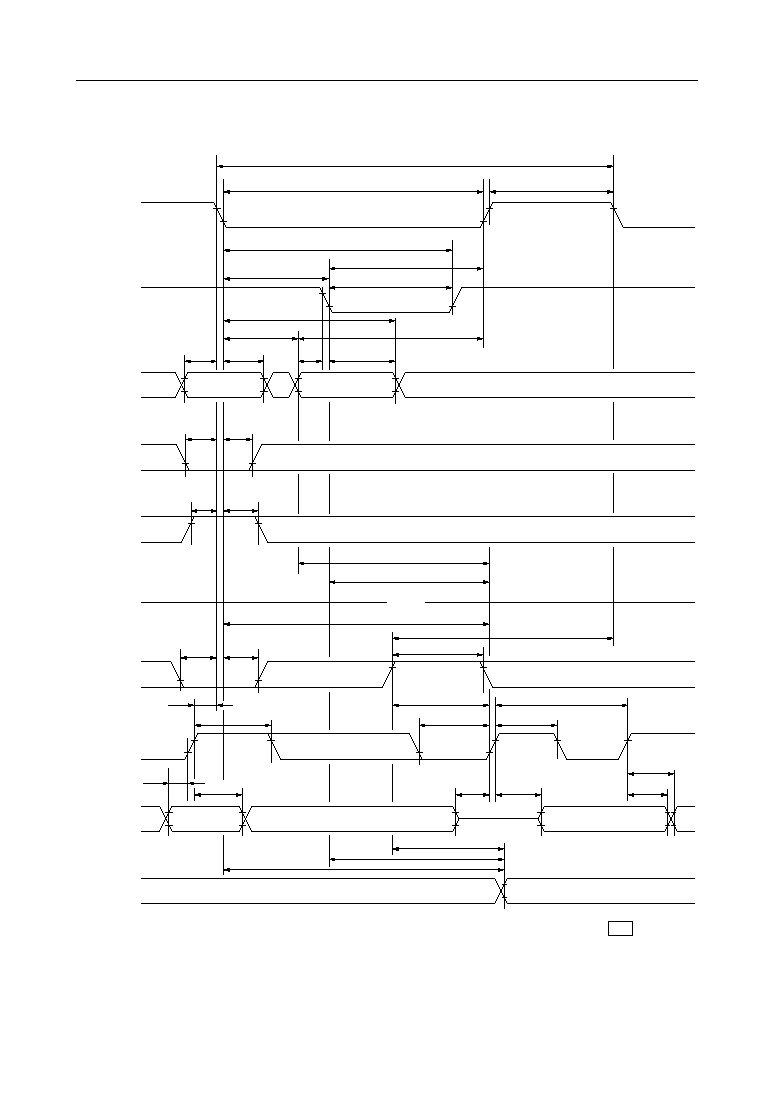
° Semiconductor
MSM548263
22/40
Read Transfer 1
Note 1:
SE = "L"
Note 2: There must be no rising transitions
Note 3: QSF = "L"-- Lower SAM (0 - 255) is active
QSF = "H"-- Upper SAM (256 - 511) is active
RAS
CAS
Address
DSF
WE
DQ1 - 8
TRG
,
,,,
t
RC
t
RAS
t
RP
t
RCD
t
CAS
t
RSH
t
CSH
t
AR
t
RAD
t
RAL
t
FSR
Row
SAM Start
t
RAH
t
ASC
t
CAH
t
RFH
t
ASR
"H" or "L"
,
,,,
t
WSR
t
RWH
t
TP
t
TLH
t
TLS
t
TRP
t
ASD
t
CSD
t
RSD
SC
t
SC
Note 2
t
SRS
t
TSD
t
SCP
t
SCC
t
SC
,
Din
t
SIH
SDQ1 - 8
t
SIS
Data Out
t
SCA
t
SZS
t
SOH
t
SCA
QSF
t
TQD
t
CQD
t
RQD
Note 3
Note 3
Open

° Semiconductor
MSM548263
23/40
Read Transfer 2 (Real Time Read Transfer)
Note 1:
SE = "L"
Note 2: QSF = "L"-- Lower SAM (0 - 255) is active
QSF = "H"-- Upper SAM (256 - 511) is active
RAS
CAS
Address
DSF
WE
DQ1 - 8
TRG
,
,,,
t
RC
t
RAS
t
RP
t
RCD
t
CAS
t
RSH
t
CSH
t
AR
t
RAD
t
RAL
t
FSR
Row
SAM Start
t
RAH
t
ASC
t
CAH
t
RFH
t
ASR
"H" or "L"
,
,,,
t
WSR
t
RWH
t
TP
t
TLS
t
TRP
t
ATH
t
CTH
SC
t
SCP
t
SC
SDQ1 - 8
Data Out
QSF
t
TQD
Note 2
Note 2
t
RTH
t
SCC
t
TSL
t
TSD
Data Out
Data Out
Data Out
t
SCA
t
SOH
t
SCA
t
SOH
Open
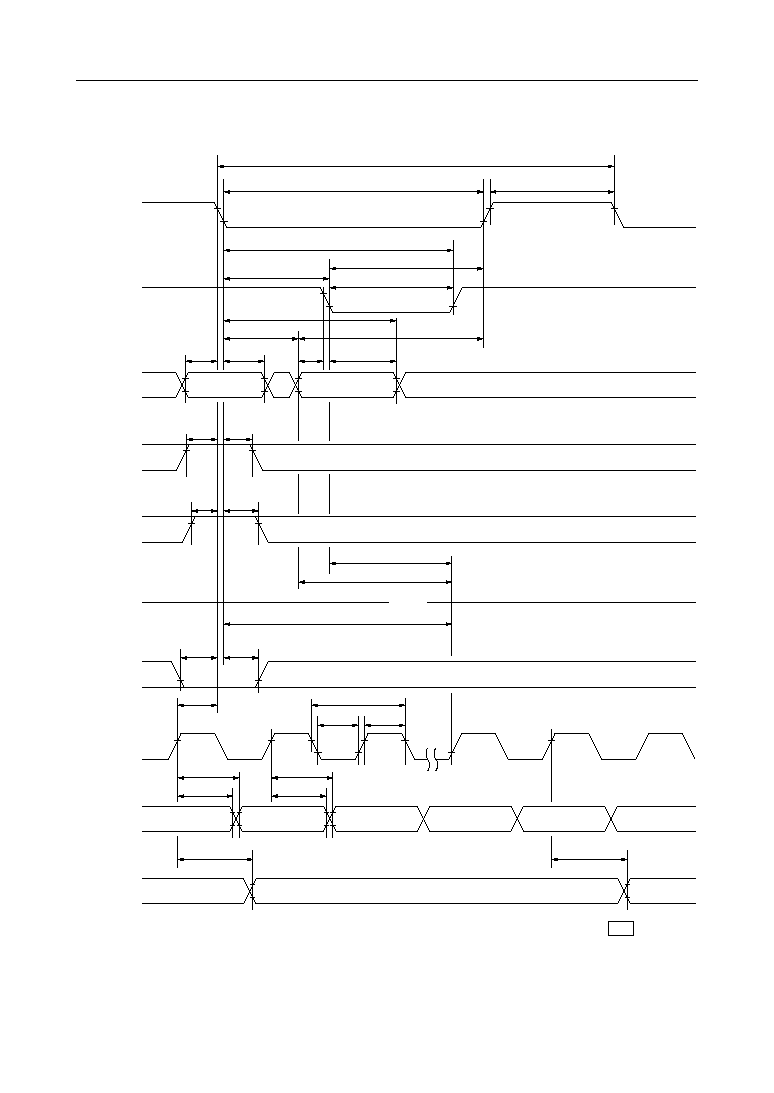
° Semiconductor
MSM548263
24/40
Split Read Transfer
Note 1:
SE = "L"
Note 2: QSF = "L"-- Lower SAM (0 - 255) is active
QSF = "H"-- Upper SAM (256 - 511) is active
Note 3: Si is the SAM start address in before SRT
Note 4: STOP i and STOP j are programmable stop addresses
RAS
CAS
Address
DSF
WE
DQ1 - 8
TRG
t
RC
t
RAS
t
RP
t
RCD
t
CAS
t
RSH
t
CSH
t
AR
t
RAD
t
RAL
t
FSR
Row
SAM Start Sj
t
RAH
t
ASC
t
CAH
t
RFH
t
ASR
"H" or "L"
,
,,,
t
WSR
t
RWH
t
TLH
t
TLS
t
CTH
t
ATH
t
RTH
SC
STOP i
S i
STOP
j - 1
STOP j
S j
t
STS
SDQ1 - 8
QSF
t
SQD
Note 2
Note 2
Data Out
Data Out
t
SOH
Data Out
t
SCA
t
SC
t
SOH
t
SCA
Data Out
Data Out
Data Out
Note 2
t
SQD
t
SCP
t
SCC
,
,,,
Open
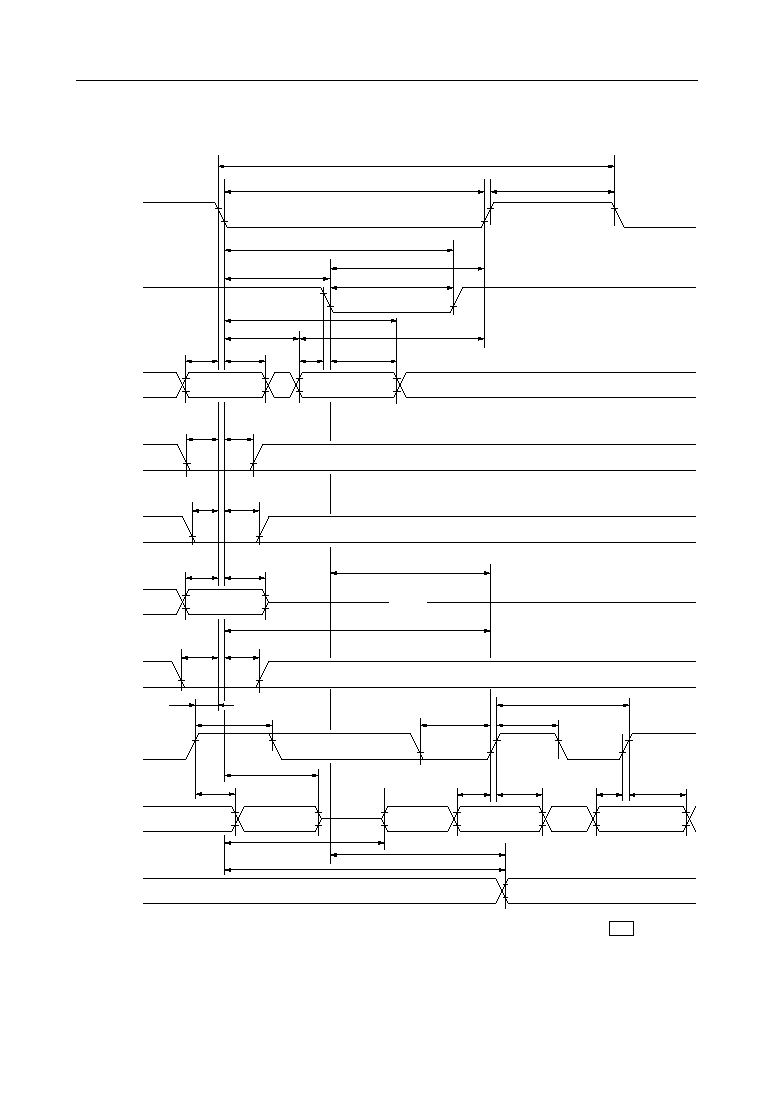
° Semiconductor
MSM548263
25/40
Masked Write Transfer
Note 1:
SE = "L"
Note 2: There must be no rising transitions
Note 3: QSF = "L"-- Lower SAM (0 - 255) is active
QSF = "H"-- Upper SAM (256 - 511) is active
RAS
CAS
Address
DSF
WE
DQ1 - 8
TRG
,
,,,
t
RC
t
RAS
t
RP
t
RCD
t
CAS
t
RSH
t
CSH
t
AR
t
RAD
t
RAL
t
FSR
Row
SAM Start
t
RAH
t
ASC
t
CAH
t
RFH
t
ASR
"H" or "L"
,
,,,
t
WSR
t
RWH
t
TLH
t
TLS
t
CSD
t
RSD
SC
t
SC
Note 2
t
SRS
t
SCP
t
SCC
t
SC
Dout
t
SDZ
SDQ1 - 8
t
SDH
t
SDS
t
SDH
QSF
t
SDD
t
CQD
t
RQD
Note 3
Note 3
Mask Data
t
MH
t
MS
Dout
t
SOH
Data In
t
SDS
Data In
Open

° Semiconductor
MSM548263
26/40
Masked Split Write Transfer
Note 1:
SE = "L"
Note 2: QSF = "L"-- Lower SAM (0 - 255) is active
QSF = "H"-- Upper SAM (256 - 511) is active
Note 3: Si is the SAM start address in before SWT
Note 4: STOP i and STOP j are programmable stop addresses
RAS
CAS
Address
DSF
WE
DQ1 - 8
TRG
,
,,,
t
RC
t
RAS
t
RP
t
RCD
t
CAS
t
RSH
t
CSH
t
AR
t
RAD
t
RAL
t
FSR
Row
SAM Start Sj
t
RAH
t
ASC
t
CAH
t
RFH
t
ASR
"H" or "L"
,
,,,
t
WSR
t
RWH
t
TLH
t
TLS
t
CTH
t
ATH
t
RTH
SC
STOP i
S i
STOP
j - 1
STOP j
S j
t
STS
SDQ1 - 8
QSF
t
SQD
Note 2
Note 2
Data In
Data In
t
SDS
Data In
t
SC
t
SDH
Note 2
t
SQD
t
SCP
t
SCC
Data In
Data In
Data In
t
SDS
t
SDH
t
MS
t
MH
Mask Data
Open

° Semiconductor
MSM548263
27/40
Serial Read Cycle
Serial Write Cycle
SE
SC
SDQ1 - 8
t
SEP
Data Out
Data
t
SEZ
t
SOH
Data Out
Data Out
t
SCC
t
SEA
t
SOH
t
SOH
t
SCA
t
SC
Data
t
SCP
t
SCA
t
SCA
SE
SC
SDQ1 - 8
t
SEP
t
SC
t
SWH
t
SCC
Data In
Data In
t
SDH
t
SDS
Data In
Data In
t
SWIH
t
SZE
t
SDS
t
SDH
t
SCP
t
SWIS
t
SWS
"H" or "L"

° Semiconductor
MSM548263
28/40
PIN FUNCTIONS
Address Input: A0 - A8
The 18 address bits decode 8 bits of the 2,097,152 locations in the MSM548263 memory array. The
address bits are multiplexed to 9 address input pins (A0 - A8) as standard DRAM. 9 row address
bits are latched at the falling edge of RAS. The following 9 column address bits are latched at the
falling edge of CAS.
Row Address Strobe: RAS
RAS is a basic RAM control signal. The RAM port is in standby mode when the RAS level is
"high". As the standard DRAM's RAS signal function, RAS is the control input that latches the
row address bits, and a random access cycle begins at the falling edge of RAS.
In addition to the conventional RAS signal function, the level of the input signals CAS, TRG, WE
and DSF at the falling edge of RAS, determines the MSM548263 operation mode.
Column Address Strobe: CAS
As the standard DRAM's CAS signal function, CAS is the control input signal that latches the
column address input and the state of the special function input DSF to select in conjunction with
the RAS control, either read/write operations or the special block write feature on the RAM port
when the DSF is held "low" at the falling edge of RAS.
CAS also acts as a RAM port output enable signal.
Data Transfer/Output Enable: TRG
TRG is also a control input signal having multiple functions. As the standard DRAM's OE signal
function, TRG is used as an output enable control when TRG is "high" at the falling edge of RAS.
In addition to the conventional OE signal function, a data transfer operation is started between
the RAM port and the SAM port when TRG is "low" at the falling edge of RAS.
Write Per Bit/Write Enable: WE
WE is a control input signal having multiple functions. As the standard DRAM's WE signal
function, this is used to write data into the memory on the RAM port when WE is "high" at the
falling edge of RAS.
In addition to the conventional WE signal function, the WE determines the write-per-bit
function, when WE is "low" at the falling edge of RAS during RAM port operations.
The WE also determines the direction of data transfer between the RAM and SAM. When the WE
is "high" at the falling edge of RAS, the data is transferred from RAM to SAM (read transfer).
When the WE is "low" at the falling edge of RAS, the data is transferred SAM to RAM (write
transfer).

° Semiconductor
MSM548263
29/40
Write Mask Data/Data Input and Output: DQ1 - DQ8
In conventional write-per bit mode, the DQ pins function as mask data at the falling edge of RAS.
Data is written only to high DQ pins. Data on low DQ pins is masked and internal data is retained.
After that, they function as input/output pins similar to a standard DRAM.
In persistent write-per-bit mode, DQ pins are don't care at the falling edge of RAS. The mask data
are determined in the mask register load cycle.
Serial Clock: SC
SC is a main serial cycle control input signal. All operations of the SAM port are synchronized
with the serial clock SC. Data is shifted in or out of the SAM registers at the rising edge of SC. In
a serial read cycle, the output data becomes valid on the SDQ pins after the maximum specified
serial access time t
SCA
from the rising edge of SC.
In a serial write cycle, data on SDQ pins at the rising edge of SC are fetched into the SAM register.
Serial Enable: SE
The SE is a serial access enable control and serial read/write control signal. In a serial read cycle,
SE is used as an output control. In a serial write cycle, SE is used as a write enable control. When
SE is "high", serial access is disabled. However, the serial address pointer location is still
incremented when SC is clocked even when SE is "high".
Special Function Input: DSF
The DSF is latched at the falling edge of RAS and CAS. It allows for the selection of several RAM
ports and transfer operating modes. In addition to the conventional multiport DRAM, the special
functions consisting of flash write, block write, load/read color register, and split read/write
transfer can be invoked.
Special Function Output: QSF
QSF is an output signal, which during split register mode indicates which half of the split SAM
is being accessed. QSF "low" indicates that the lower split SAM (0 - 255) is being accessed. QSF
"high" indicates that the upper SAM (256 - 511) is being accessed.
Serial Input/Output: SDQ1 - SDQ8
Serial input/output mode is determined by the most recent read or write transfer cycle. When
a read transfer cycle is performed, the SAM port is in the output mode. When a write or pseudo
write transfer cycle is performed, the SAM port is switched from output mode to input mode.

° Semiconductor
MSM548263
30/40
OPERATION MODES
Table-1 shows the function truth table for a listing of all available RAM ports and transter
operation of MSM548263.
The RAM port and data transfer operations are determined by the state of CAS, TRG, WE and
DSF at the falling edge of RAS, and by the level of DSF at the falling edge of CAS.
Table-1. Function Truth Table
RASÿ
Code
Address
CAS TRG WE DSF DSF
RASÿ
CAS
Write Pers.
WM
Color
0
*
1
0
--
*
*
*
*
--
Reset Reset
--
CBRR
CASÿ
/WE
ÿ
Mask W.M.
RASÿ
W/IO
CASÿ
Register
Function
CBR Refresh
(Register Reset)
0
*
0
1
--
STOP
*
*
*
--
--
--
--
CBRS
CBR Refresh
(Stop Register Set)
0
*
1
1
--
*
*
*
*
--
--
--
--
CBRN
CBR Refresh (No Reset)
1
1
*
0
--
Row
--
*
--
--
--
--
--
ROR
RAS Only Refresh
1
0
0
0
*
Row TAP WM1
*
Yes
No/ Load
--
MWT
Masked Write Transfer
1
0
0
1
*
Row TAP WM1
*
Yes
No/
--
MSWT
Masked Split
Write Transfer
1
0
1
0
*
Row TAP
*
*
--
--
--
--
RT
Read Transfer
1
0
1
1
*
Row TAP
*
*
--
--
--
--
SRT
Split Read Transfer
1
1
0
0
0
Row
Column
WM1
Din, Dout
Yes
No/
--
RWM
Read/Write
(New/Old Mask)
1
1
0
0
1
Row
Column
WM1
Yes
No/
Use
BWM
Masked Block Write
(New/Old)
1
1
0
1
*
Row
*
WM1
--
Yes
No/
Use
FWM
Masked Flash Write
(New/Old)
1
1
1
0
0
Row
Column
*
Din, Dout
No
No
--
--
RW
Read/Write
(No Mask)
1
1
1
0
1
Row
*
No
No
--
Use
BW
Block Write
(No Mask)
1
1
1
1
0
Row
*
*
--
Set Load
--
LMR
Load Mask Register
(Old Mask Set)
1
1
1
1
1
Row
*
*
--
--
--
Load
LCR
Load Color Register
A2c - 8c
Column
A2c - 8c
Column
Select
Column
Select
Mask
Data
Color
Data
Use
Load
Use
Load
Use
Load
Use
Load
Use
Yes
Yes
Yes
Yes
Yes
Notes:
1. With CBRS and SAM operations use stop register
2. After LMR, RWM, BWM, FWM and MSWT, use old mask which can be reset by
CBRR.

° Semiconductor
MSM548263
31/40
If the DSF is "high" at the falling edge of RAS, special functions such as split transfer, flash write,
load mask register, load color register, CBRS and CBRN can be invoked.
If the DSF is "low" at the falling edge of RAS and "high" at the falling edge of CAS, the block write
feature can be invoked.
RAM PORT OPERATION
Extended RAM Read Cycle: RAS falling edge --- TRG = CAS = "H", DSF = "L"
CAS falling edge --- DSF = "L"
The MSM548263 offers an accelerated page mode cycle (EXTENDED PAGE MODE) by eliminating
output disable from CAS "high", and it allows CAS precharge time (t
CP
) to occur without the
output data becoming invalid. This new data out operates (Extended data out) as any RAM read
or Page Mode Read, except data will be held valid after CAS goes "high", as long as RAS is "low".
RAM Write Cycle: RAS falling edge --- TRG = CAS = "H", DSF = "L"
CAS falling edge --- DSF = "L"
1) Write cycle with no mask: RAS falling edge -- WE = "H"
If WE is set "low" at the falling edge of CAS after RAS goes "low", a write cycle is excuted. If WE
is set "low" before the CAS falling edge, this cycle becomes an early write cycle, and all DQ pins
attain high impedance. All 8 data are latched on the falling edge of CAS.
If WE is set "low" after the CAS falling edge, this cycle becomes a late write cycle, and all 8 data
are latched on the falling edge of WE.
2) Write cycle with mask: RAS falling edge -- WE = "L"
If WE is set "low" at the falling edge of RAS, two modes of mask write can be invoked.
#1 In new mask mode mask data is loaded and used. The mask data on DQ1 - DQ8 is latched into
the write mask register at the falling edge of RAS. When the mask data is low, writing is inhibited
into the RAM and the mask data is high, data is written into the RAM. This mask data is in effect
during the RAS cycle. In page mode cycle the mask data is retained during page access.
#2 If a load mask register cycle (LMR) has been performed, the mask data is not loaded from DQ
pins, and the mask data stored in the mask register is persistently used.
This operation is known as persistent write mask, set by LMR and reset by CBRR.

° Semiconductor
MSM548263
32/40
Load/Read Color Register:
RAS falling edge --- CAS = TRG = WE = DSF = "H"
CAS falling edge --- DSF = "H"
The MSM548263 is provided with an on-chip 8-bit color register for use during the flash write or
block write operation. Each bit of the color register corresponds to one of the DRAM I/O blocks.
The data presented on the DQi lines is subsequently latched into the color register at the falling
edge of either CAS or WE whichever occurs later.
The read color register cycle is activated by holding WE "high" at the falling edge of CAS, and
throughout the remainder of the cycle. The data in the color register becomes valid on the DQi
lines after the specified access times from RAS and TRG are satisfied.
During the load/read color register cycle, the memory cells on the row address latched at the
falling edge of RAS are refreshed.
Load/Read Mask Register:
RAS falling edge --- CAS = TRG = WE = DSF = "H"
CAS falling edge --- DSF = "L"
The MSM548263 is provided with an on-chip 8-bit mask register for use during the mask write
cycle, flash write cycle, block write cycle, masked write transfer, and masked split write transfer.
Each bit of the mask register corresponds to one of the DRAM I/O blocks.
The data presented on the DQi lines is subsequently latched into the mask register at the falling
edge of either CAS or WE whichever occurs later.
The read mask register cycle is activated by holding WE "high" at the falling edge of CAS, and
throughout the remainder of the cycle. The data in the mask register becomes valid on the DQi
lines after the specified access times from RAS and TRG are satisfied.
During the load/read mask register cycle, the memory cells on the row address latched at the
falling edge of RAS are refreshed.
Flash Write: RAS falling edge --- CAS = TRG = DSF = "H", WE = "L"
Flash write allows for the data in the color register to be written into all the memory locations of
a selected row.
Each bit of the color register corresponds to one of the DRAM I/O blocks. The flash write
operation can be selectively controlled on an I/O basis in the same manner as the write per bit
operation. The mask data is the same as that of a RAM write cycle.

° Semiconductor
MSM548263
33/40
Block Write: RAS falling edge --- CAS = TRG = "H", DSF = "L"
CAS falling edge --- DSF = "H"
Block write allows for the data in the color register to be written into 4 consecutive column
address locations, starting from a selected column address in a selected row.
The block write operation can be selectively controlled on an I/O basis, and a column mask
capability is also available. During a block write cycle, the 2 least significant column address
locations (A0C and A1C) are internally controlled, and only the 7 most significant column
addresses (A2C - A8C) are latched at the falling edge of CAS.
1) No mask block write: WE "high" at the falling edge of RAS
The data on 8 DQ pins is all cleared by the data of the color register.
2) Masked block write: WE "low" at the falling edge of RAS
The mask data is the same as that of a RAM write cycle.
SAM PORT OPERATION
Single Register Mode
High speed serial read or write operation can be performed through the SAM port independent
of the RAM port operation, except during read/write transfer cycles.
The preceding transfer operation determines the direction of data flow through the SAM port.
If the preceding transfer is a read transfer, the SAM port is in the output mode. If the preceding
transfer is write transfer, the SAM port is in the input mode.
Serial data can be read out of the SAM after a read transfer has been performed. The data is shifted
out of the SAM starting at any of the 512 bits locations.
The TAP location corresponds to the column address selected at the falling edge of CAS during
the read or write transfer cycle. The SAM registers are configured as a circular data register. The
data is shifted out sequentially. It starts from the selected TAP location at the most significant bit
(511), then wraps around to the least significant bit (0).
Split Register Mode
In split register mode data can be shifted into or out of one half of the SAM, while a split read or
split write transfer is being performed on the other half of the SAM.
Conventional (non split) read, or write transfer cycle must precede any split read or split write
transfers. The split read and write transfers will not change the SAM port mode set by the
preceding conventional transfer operation. In the split register mode, serial data can be shifted
in or out of one of the split SAM registers, starting from any at the 256 TAP locations, excluding
the last address of each split SAM the data is shifted in or out sequentially starting from the
selected TAP location at the most significant bit (255 or 511) of the first split SAM, and then the
SAM pointer moves to the TAP location selected for the second split SAM to shift data in or out
sequentially, starts from this TAP location at the most significant bit (511 or 255), and finally
wraps around to the least significant bit.
0
1
2
255
TAP
256 257
511
TAP
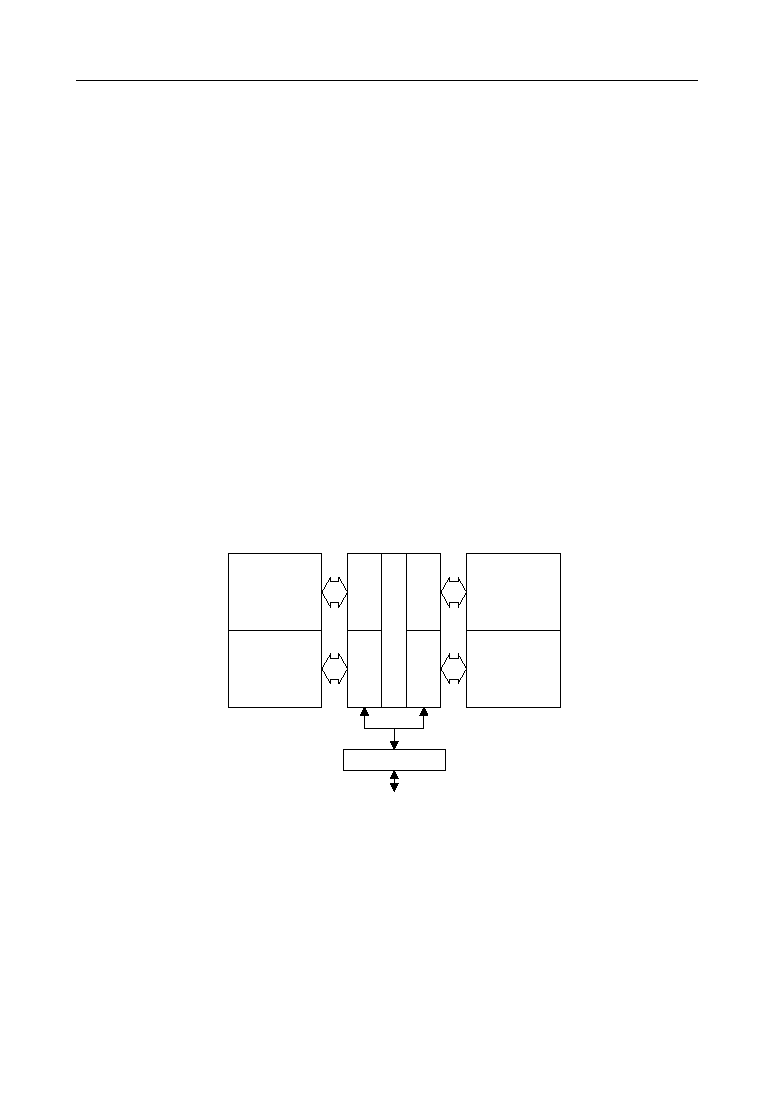
° Semiconductor
MSM548263
34/40
DATA TRANSFER OPERATIONS
The MSM548263 features two types of bidirectional data transfer capability between RAM and
SAM.
1) Conventional (non split) transfer: 512 words by 8 bits of data can be loaded from RAM to SAM
(Read transfer), or from SAM to RAM (Write transfer).
2) Split transfer: 256 words by 8 bits of data can be loaded from the lower/upper half of the RAM
to the lower/upper half of the SAM (Split read transfer), or from the lower/upper half of SAM
to the lower/upper half of RAM (Split write transfer).
The conventional transfer and split transfer modes are controlled by the DSF input signal.
Data transfer are invoked by holding the TRG signal "low" at the falling edge of RAS.
The MSM548263 supports 4 types of transfer operations: Read transfer, Split read transfer, Write
transfer and Split write transfer as shown in the truth table. The type of transfer operation is
determined by the state of CAS, WE and DSF latched at the falling edge of RAS. During
conventional transfer operations, the SAM port is switched from input to output mode (Read
transfer), or output to input mode (Write transfer). It remains unchanged during split transfer
operation (Split read transfer or Split write transfer).
Both RAM and SAM are divided by the most significant row address (AX8), as shown in Figure
1. Therefore, no data transfer between AX8 = 0 side RAM and AX8 = 1 side RAM can be provided
through the SAM. Care must be taken if the split read transfer on AX8 = 1 side (or AX8 = 0 side)
is provided after the read transfer or the split read transfer, is provided on AX8 = 0 side (or AX8
= 1 side).
Figure 1. RAM and SAM Configuration
256 • 256 • 8
Memory
Array
256 • 256 • 8
Memory
Array
256 • 256 • 8
Memory
Array
256 • 256 • 8
Memory
Array
Serial Decoder
Upper SAM
256
•
8
Lower SAM
256
•
8
Upper SAM
256
•
8
Lower SAM
256
•
8
AX8 = 0
AX8 = 1
SAM I/O Buffer
SDQ1 - 8

° Semiconductor
MSM548263
35/40
Read Transfer: RAS falling edge --- CAS = WE = "H", TRG = DSF = "L"
Read transfer consists of loading a selected row of data from the RAM into the SAM register. A
read transfer is invoked by holding CAS "high", TRG "low", WE "high", and DSF "low" at the
falling edge of RAS. The row address selected at the falling edge of RAS determines the RAM row
to be transferred into the SAM. The transfer cycle is completed at the rising edge of TRG. When
the transfer is completed, the SAM port is set into the output mode. In a read/real time read
transfer cycle, the transfer of a new row of data is completed at the rising edge of TRG, and this
data becomes valid on the SDQ lines after the specified access time t
SCA
from the rising edge of
the subsequent SC cycles. The start address of the serial pointer of the SAM is determined by the
column address selected at the falling edge of CAS. In a read transfer cycle (which is preceded
by a write transfer cycle), SC clock must be held at a constant V
IL
or V
IH
after the SC high time
has been satisfied. A rising edge of the SC clock must not occur until after the specified delay t
TSD
from the rising edge of TRG.
In a real time read transfer cycle (which is preceded by another read transfer cycle), the previous
row data appears on the SDQ lines until the TRG signal goes "high", and the serial access time
t
SCA
for the following serial clock is satisfied. This feature allows for the first bit of the new row
of data to appear on the serial output as soon as the last bit of the previous row has been strobed
without any timing loss. To make this continuous data flow possible, the rising edge of TRG must
be synchronized with RAS, CAS, and the subsequent rising edge of SC (t
RTH
, t
CTH
, and t
TSL
/t
TSD
must be satisfied).
Masked Write Transfer: RAS falling edge --- CAS = "H", TRG = WE = DSF = "L"
Write transfer cycle consists of loading the content of the SAM register into a selected row of the
RAM. This write transfer is the same as a mask write operation in RAM, so new and persistent
(old) mask mode can be supported. (Masked write transfer)
If the SAM data to be transferred must first be loaded through the SAM, a Masked write transfer
operation (all DQ pins "low" at falling edge of RAS) must precede the write transfer cycles. A
masked write transfer is invoked by holding CAS "high", TRG "low", WE "low" and DSF "low"
at the falling edge of RAS. The row address selected at the falling edge of RAS determines the
RAM row address into which the data will be transferred. The column address selected at the
falling edge of CAS determines the start address of the serial pointer of the SAM. After the write
transfer is completed, the SDQ lines are set in the input mode so that serial data synchronized
with the SC clock can be loaded.
When consecutive write transfer operations are performed, new data must not be written into
the serial register until the RAS cycle of the preceding write transfer is completed. Consequently,
the SC clock must be held at a constant V
IL
or V
IH
during the RAS cycle. A rising edge of the SC
clock is only allowed after the specified delay t
CSD
from the falling edge of the CAS, at which time
a new row of data can be written in the serial register.
Data transferred to SAM by read transfer cycle or split read transfer cycle can be written to the
other address of RAM by write transfer cycle. However, the address to write data must be the
same as that of the read transfer cycle (row address AX8).

° Semiconductor
MSM548263
36/40
Split Data Transfer and QSF
The MSM548263 features a bidirectional split data transfer capability between the RAM and
SAM. During split data transfer operation, the serial register is split into two halves which can
be controlled independently. Split read or split write transfer operation can be performed to or
from one half of the serial register, while serial data can be shifted into or out of the other half of
the serial register. The most significant column address location (A8C) is controlled internally to
determines which half of the serial register will be reloaded from the RAM. QSF is an output
which indicates which half of the serial register is in an active state. QSF changes state when the
last SC clock is applied to active split SAM.
Split Read Transfer: RAS falling edge --- CAS = WE = DSF = "H", TRG = "L"
The MSM548263 supports two types of split register operation.
#1 Normal split register operation
#2 Boundary split register operation using programmable SAM stops described later.
Normal split read transfer consists of loading 256 words by 8 bits of data from a selected row of
the split RAM into the corresponding non-active split SAM register. Serial data can be shifted out
from the other half of the split SAM register simultaneously. During split read transfer operation,
the RAM port input clocks do not have to be synchronized with the serial clock SC, thus
eliminating timing restrictions as in the case of real time read transfers. A split read transfer can
be performed after a delay of t
STS
from the change of state of the QSF output is satisfied.
Conventional (non-split) read transfer operation must precede split read transfer cycles.

° Semiconductor
MSM548263
37/40
Masked Split Write Transfer: RAS falling edge --- CAS = DSF = "H", TRG = WE = "L"
Split write transfer consists of loading 256 words by 8 bits of data from the non-active split SAM
register into a selected row of the corresponding split RAM. Serial data can be shifted into the
other half of the split SAM register simultaneously. During split write transfer operation, the
RAM port input clocks do not have to be synchronized with the serial clock SC, thus allowing
for real time transfer. This operation is the same as a mask write operation in RAM, so new and
persistent mode can be supported.
A split write transfer can be performed after a delay of t
STS
from the change of state of the QSF
output is satisfied.
A masked write transfer operation must precede split write transfer. The purpose is to switch the
SAM port from output mode to input mode, and to set the initial TAP location prior to split write
transfer operations.
Programmable SAM Stops in Split Transfer Cycle
The MSM548263 has a boundary split register operation using programmable stops. If a CBRS
cycle has been performed, the split transfer cycle performs the boundary operation.
Figure 2 shows an example of a boundary split register (4 stop points). The stop points define a
SAM location at which the access will change from one half of the SAM to the other half (at the
TAP address).
0
TAP1
255
TAP3
Lower SAM
256
511
Upper SAM
TAP2
S.T. (TAP2)
S.T. (TAP3)
Figure 2. Example of Boundary Split Register
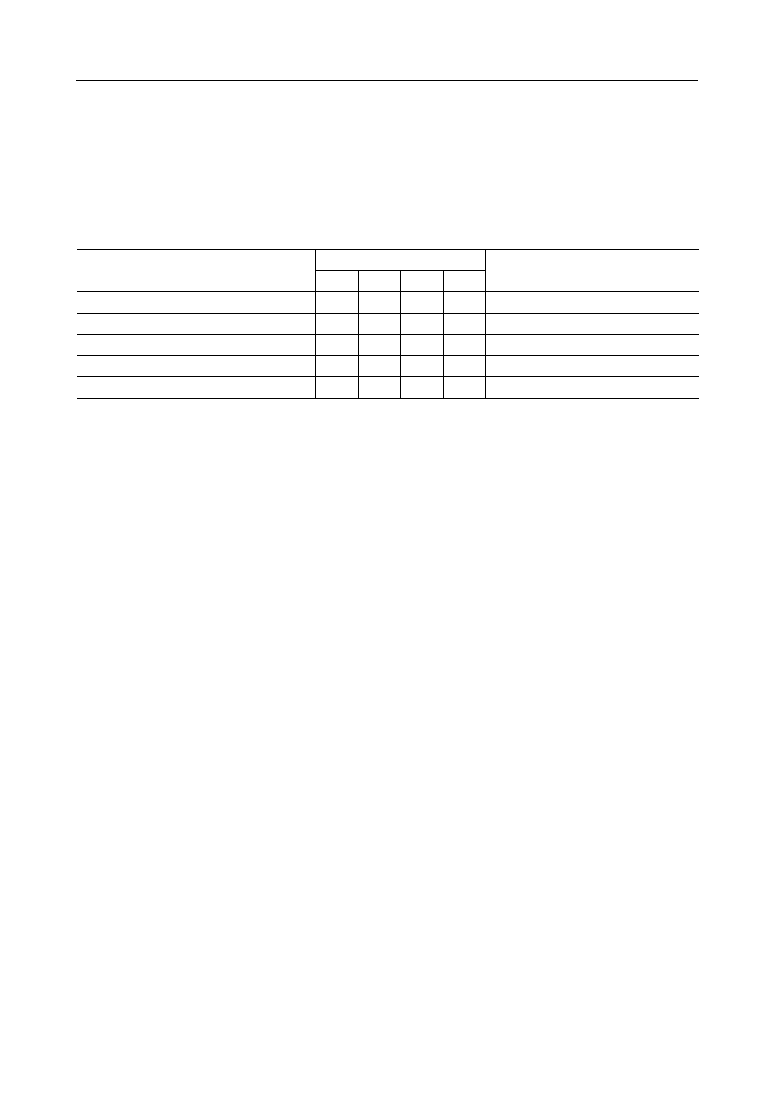
° Semiconductor
MSM548263
38/40
SAM Stop Set Cycle (CBRS): RAS falling edge --- CAS = "L", WE = "L", DSF = "H"
SAM Stop location data (boundaries) are latched from address inputs at the falling edge of RAS.
To determine the boundary A4 - A7 are used, and A0 - A3, and A8 are ignored.
Once the CBRS is executed, the programmable SAM stop operation continues until CBRR.
SAM Stop Boundary Table
Number of Stop Points
1
2
4
8
16
Address
A4
1
1
1
1
0
A5
1
1
1
0
X
A6
1
1
0
X
X
A7
1
0
X
X
X
256
128
64
32
16
Size of Partition
Register Reset Cycle (CBRR): RAS falling edge --- CAS = "L", WE = "H", DSF = "L"
A CBRR can reset the programmable SAM stop operation, and persistent mask write operation.
The CBRR will take effect immediately; it doesn't require a split transfer cycle.
POWER UP
Power must be applied to the RAS and TRG input signals to pull them "high" before, or at the
same time as, the V
CC
supply is turned on. After power-up, a pause of 200 ms minimum is
required with RAS and TRG held "high". After the pause, a minimum of 8 RAS and 8 SC dummy
cycles must be performed to stabilize the internal circuitry, before valid read, write or transfer
operations can begin. During the initialization period, the TRG signal must be held "high". If the
internal refresh counter is used, a minimum 8 CAS before RAS cycles are required instead of 8
RAS cycles.
(NOTE) INITIAL STATE AFTER POWER UP
The initial state can not be guaranteed for various power up conditions and input signal levels.
Therefore, it is recommended that the initial state be set (ex. Perform a CBRR cycle to select Non
Persistent Write-per-bit mode) after the initialization of the device is performed and before valid
operations begin.

° Semiconductor
MSM548263
39/40
(Unit : mm)
PACKAGE DIMENSIONS
Notes for Mounting the Surface Mount Type Package
The SOP, QFP, TSOP, SOJ, QFJ (PLCC), SHP and BGA are surface mount type packages, which
are very susceptible to heat in reflow mounting and humidity absorbed in storage.
Therefore, before you perform reflow mounting, contact Oki's responsible sales person for the
product name, package name, pin number, package code and desired mounting conditions
(reflow method, temperature and times).
SOJ40-P-400-1.27
Package material
Lead frame material
Pin treatment
Solder plate thickness
Package weight (g)
Epoxy resin
42 alloy
Solder plating
5 mm or more
1.70 TYP.
Mirror finish
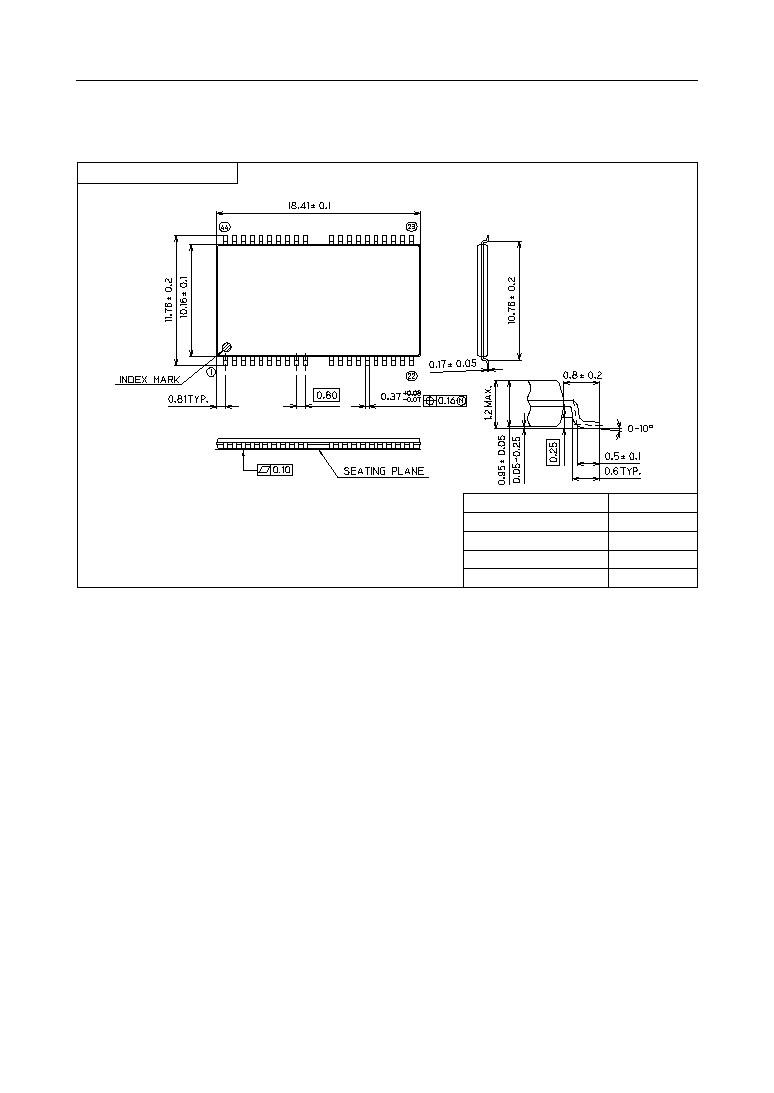
° Semiconductor
MSM548263
40/40
(Unit : mm)
Notes for Mounting the Surface Mount Type Package
The SOP, QFP, TSOP, SOJ, QFJ (PLCC), SHP and BGA are surface mount type packages, which
are very susceptible to heat in reflow mounting and humidity absorbed in storage.
Therefore, before you perform reflow mounting, contact Oki's responsible sales person for the
product name, package name, pin number, package code and desired mounting conditions
(reflow method, temperature and times).
Package material
Lead frame material
Pin treatment
Solder plate thickness
Package weight (g)
Epoxy resin
42 alloy
Solder plating
5 mm or more
0.49 TYP.
TSOP
II44/40-P-400-0.80-K
Mirror finish







































